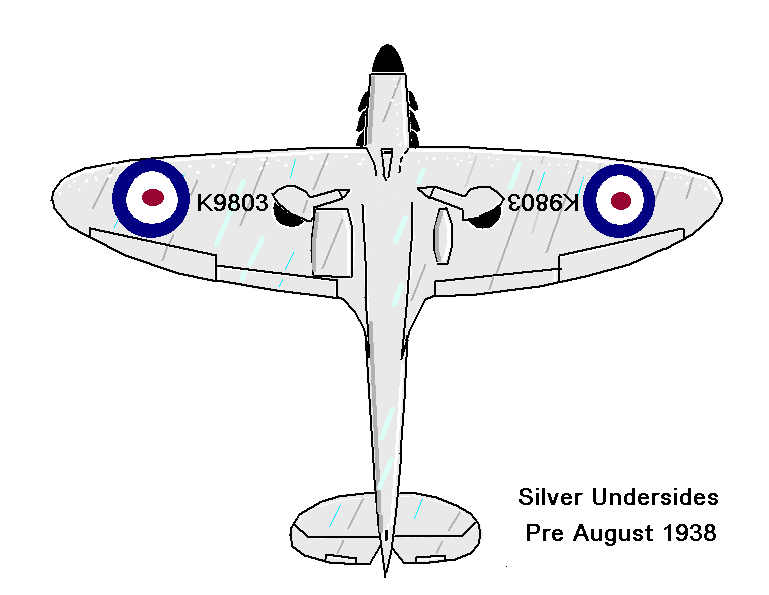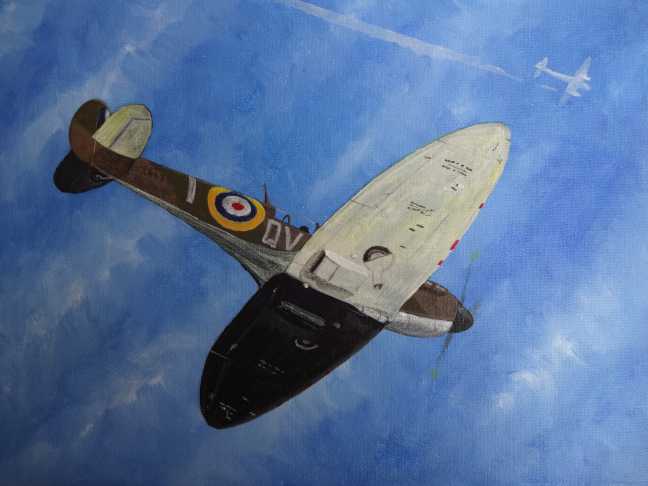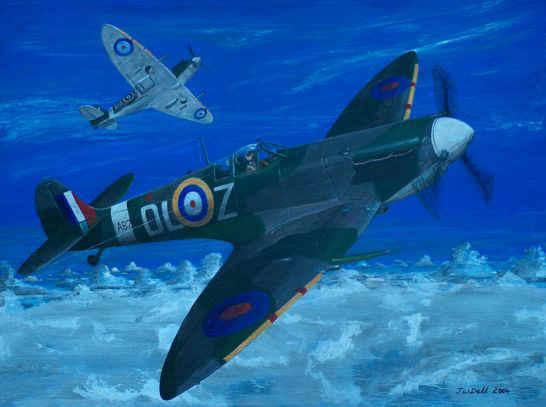Dinger's Aviation Pages
SPITFIRE MARKINGS AND CAMOUFLAGE
The subject of Spitfire camouflage and markings is a huge one, this page gives only a brief overview.
The low-resolution and limited colour palette of some of the images are due to them being drawn in the 1990s for use on Amiga and DOS PCs.

P7350 is an early production Spitfire Mk II, it was shot down on the 25th October 1940. Its Polish pilot survived and the Spitfire was repaired and returned to service. It still flies today with the Battle of Britain Memorial Flight. It is the only surviving airworthy Mk II. This photo shows it after it appeared in the film "Battle of Britain"in 1969. The overall colour scheme is correct, but it has a much more glossy finish than it would have worn during WW2. It carries the "ZH" code of 266 Squadron, but that was not a code carried by 266 Squadron Spitfires during the Battle of Britain. The squadron used the code "UO" from 1940 through until June 1942, by which time it had replaced its Spitfires with Hawker Typhoons.
Serial Numbers and Squadron Codes
The subject of Spitfire camouflage and markings is a huge one, this page gives only a brief overview.
The low-resolution and limited colour palette of some of the images are due to them being drawn in the 1990s for use on Amiga and DOS PCs.

P7350 is an early production Spitfire Mk II, it was shot down on the 25th October 1940. Its Polish pilot survived and the Spitfire was repaired and returned to service. It still flies today with the Battle of Britain Memorial Flight. It is the only surviving airworthy Mk II. This photo shows it after it appeared in the film "Battle of Britain"in 1969. The overall colour scheme is correct, but it has a much more glossy finish than it would have worn during WW2. It carries the "ZH" code of 266 Squadron, but that was not a code carried by 266 Squadron Spitfires during the Battle of Britain. The squadron used the code "UO" from 1940 through until June 1942, by which time it had replaced its Spitfires with Hawker Typhoons.
Serial Numbers and Squadron Codes
RAF aircraft usually carried two sets of characters. The first was in quite small black or dark letters near the tail on both sides of the fuselage. This was that aircraft's serial number and would stay with it throughout its service life, the only problems arise when one good airframe was made out of two damaged ones! The other was a three (very rarely four) letter code in large light characters (a light grey was the official colour specified) arranged around the fuselage roundel. First introduced in April of 1939,the first two letters were the code of the squadron the aircraft was with, for example, "XT" was 603 Squadron in 1941. The remaining letter was the individual code of that aircraft within the squadron. So if you were with 603 Squadron and were told to take off in "baker" aircraft you would walk out to the aircraft with XT-B on its side. Since most fighter squadrons would only have eighteen aircraft at maximum there was no need for any other letters, on the odd occasion that a squadron did acquire more than 26 aircraft it might start again with "AA". The squadron markings of an aircraft would change any time it was acquired by a new unit. The RAF would change the squadron code if it ever thought the Germans had managed to tie the code to a particular squadron, so the code of a squadron might have changed during the course of the war. The codes were deliberately painted on as large as possible so that pilots could identify planes from their squadron, to form up into formation again after a dogfight. The only exception to this code-scheme were Wing-Commanders, that is the officers who commanded a Wing of two, three or more squadrons, usually flying from a common airfield, or "clutch" of airfields. Thus the famous Douglas Bader was allowed to have the letters "D-B" painted on the side of his Spitfire VA because he commanded the Wing flying from Tangmere Aerodrome. Bob Stanford-Tuck, commander of the Biggin Hill Wing had a Spitfire with "RS-T" on it.

Spitfire, serial number R6923 of No 92 "East India" Squadron in the Spring of 1941. It carries the Squadron code "QJ" and the individual aircraft letter "S". This aircraft was originally built as a Spitfire Mark I in August of 1940. It was later updated to Mk Vb standard. It was lost in combat in June 1941.
Colours and Camouflage
The first Spitfire, the prototype K5054, was first flown unpainted. Later a finish of "float-plane blue" was applied.

The Spitfire prototype, K5054 in its "float-plane blue" scheme. It had black serials on the rudder and the black serials on the fuselage were outlined in white.
The first Spitfires to reach the RAF were painted in a camouflage scheme of brown (called "dark earth") and dark green. The first Spitfires in service had silver undersurfaces, but this was soon replaced with a scheme where the undersides were painted with one-half black, the other white, with the dividing line running from nose to tail, sometimes only the underside of one wing was painted black, leaving the fuselage underside white or silver. The idea behind this underside colour scheme was to aid the identification of RAF fighters at height through binoculars by the Observer Corps and anti-aircraft artillery. With this scheme, there were usually no roundels under the wings.

Spitfire underside markings from 1938 until 1944 (gif animation).
Click here for an explanation of why the black and white underside colour scheme was adopted.

Above: The half-black, half-white undersides used by Spitfires through until the end of the Dunkirk evacuation.

A Spitfire of 19 Squadron (the first Squadron to receive Spitfires). When first delivered, they carried the Squadron number on the tail and had "A1" style roundels on the wings. This scheme did not last long, type "B" red/blue roundels becoming standard on top of the wings. At this early stage, the undersurfaces would have been silver with black serials under the wings.

Another 19 Squadron Spitfire after the adoption of Squadron codes. Notice the underwing roundel is small and positioned close to the wingtip, used on some Spitfires during the Battle of Britain.

Above: The half-black, half-white undersides used by Spitfires through until the end of the Dunkirk evacuation.

A Spitfire of 19 Squadron (the first Squadron to receive Spitfires). When first delivered, they carried the Squadron number on the tail and had "A1" style roundels on the wings. This scheme did not last long, type "B" red/blue roundels becoming standard on top of the wings. At this early stage, the undersurfaces would have been silver with black serials under the wings.

Another 19 Squadron Spitfire after the adoption of Squadron codes. Notice the underwing roundel is small and positioned close to the wingtip, used on some Spitfires during the Battle of Britain.
Spitfires were delivered from factories in this scheme until the start of June 1940. In that month Fighter Command squadrons were instructed to paint the entire underside of fighters a duck-egg green colour called "sky". During the following months there were shortages of the official colour so a range of available paints and locally mixed colours were often used, resulting in varying shades of light-blue and duck-egg blue. From August 1940, underwing roundels were introduced.

Spitfire Mk I of 19 Squadron, the first squadron to fly Spitfires.
At the end of November 1940, the black-painted port wing undersurface was reintroduced as standard. This time the rest of the undersurface was "sky" and underwing roundels were carried, that on the starboard undersurface usually being outlined in yellow to make it stand out. This scheme was worn through the winter of 1940/41 until April 1941.

Spitfires in Brown and Green camouflage. Note the type "A1" fuselage roundels.
The upper-surface brown and green camouflage saw the RAF through the Battle of Britain and into 1941. With them now taking the fight to the enemy and having to cross the Channel or the North Sea to do it, the brown part of the camouflage stood out against the sea. So it was changed to a dark grey colour called "Ocean Grey", a scheme of grey and green being equally good over land or sea. At the same time, the lower surfaces were painted a lighter shade of grey, called "Medium Sea Grey". During the early war years, it had been normal for the propeller spinner to be painted black, from late 1940 this was increasingly switched to "Sky" and in early 1941 a thin band of "Sky" was painted around the rear fuselage as an aid to identification. To aid quick identification of aircraft joining up with a formation from the rear, yellow leading-edges to the wings were introduced.

Spitfire Mk V of early 1942 - After the switch to grey and green camouflage but before the adoption of "type C" fuselage and underwing roundels with their reduced white band. Note the yellow leading-edge of the wing with dull red fabric patches over the machine-gun ports.

A clipped-wing Spitfire Mk Vb showing the grey-green colour scheme with "Type C1" fuselage roundel with yellow outer ring.

A clipped-wing Spitfire Mk Vb showing the grey-green colour scheme with "Type C1" fuselage roundel with yellow outer ring.

Spitfires - One dark earth and dark green with type "A1" roundel and one ocean grey and dark green with type "C1" roundel.
During the winter of 1941/42, two squadrons of Spitfires (nos 111 and 65) were dedicated to the night fighter role in "Operation Smack". They were given an all-over finish of black paint and had their engine exhausts covered with red lead to mask the glow they emitted.

Spitfire Mk Vb, 111 Squadron, Winter 1941-42. "Operation Smack" night fighter with black colour scheme.
Spitfires employed in the reconnaissance role often employed special camouflage. High-altitude aircraft were painted a dark shade of blue overall (known as PR blue). Low-level aircraft were sometimes painted a pale pink, this unusual colour proved very good at hiding the aircraft against a background of low cloud, particularly on missions flown early in the early morning or late evening.

Photo-reconnaissance Spitfire Mk XII in "PRU blue" with "D-Day stripes".

Spritfire PR Mk VII (PR IG) in the pale pink colour scheme used for low-level reconnaissance.

Spritfire PR Mk VII (PR IG) in the pale pink colour scheme used for low-level reconnaissance.
In the Middle East, Spitfires were painted with "sand and stone" upper surfaces for operation over the desert. The undersurfaces were a much darker blue, "azure blue" to suit the more intense blue of the sky in that theatre of war.


Restored Spitfire LF IX painted in the desert colours as used by 92 Sqdn in Tunisia in 1943. It carries a non-standard numerical individual aircraft identification code "3" rather than a letter.

Roundels
The RAF symbol of concentric red white and blue discs, known as a roundel, was carried on the top and bottom of the wings and the side of the fuselage. The roundels on the top of the wing had the white missing leaving only red and blue (the so-called "type B" roundel). This helped the aircraft be less easily seen, particularly if it was on the ground. The roundels on the side of the fuselage and under the wing (the latter not always present) were of the normal "A" type. The fuselage roundels were then surrounded by another ring of yellow to make it stand out from the background camouflage (this was known as the "A1" roundel). From mid-1942 the roundels on the side of the fuselage and under the wings had the white band reduced in thickness (called the "type C" roundel or "Type C1" if it had a thin yellow ring around it).
In the Far East, the roundel had the red centre removed to stop it from being confused with the red disk "Hinomaru" emblem of the Japanese.
In the Far East, the roundel had the red centre removed to stop it from being confused with the red disk "Hinomaru" emblem of the Japanese.

Spitfire Mk VIII fighters in the Far East, showing the lack of the red middle to the roundel to avoid misidentification as a Japanese "Hinomaru".
Fin Flashes
Fin Flashes
During the period of the "phoney war" Spitfires did not carry any national markings on their tails. In light of increasing incidences of "friendly fire", these were introduced in May 1940 in the form of fin flashes of red, white and blue stripes (red always towards the front of the aircraft). At first, each colour was 7 inches wide (meaning the total flash was 21 inches wide) and went all the way to the top on the non-moving part of the fin. Later, each stripe was increased to 8 inches wide (24 inches total width) but was limited to only 27 inches high, stopping short of the top of the non-moving fin. Later still (May 1942), the height of the flash was reduced to 24 inches and the width of the central white stripe was reduced to only 2 inches while the other stripes were expanded to 11 inches to retain the 24-inch overall width.

Grey and Green Camouflage Spitfires - Note the type "C1" roundels on the RAF example.

Over 1,000 Spitfires were supplied to the USA under "Reverse Lend-Lease". They mostly retained British camouflage but carried US insignia. This restored Mk Vb Spitfire, original serial RW382, has been painted to represent a Spitfire operated by the USAAF 309th Fighter Squadron.
D-Day Stripes
For D-Day and the invasion of Europe Allied aircraft had black and white "invasion stripes" painted on the wings and fuselage. This helped identify them as friendly to their own anti-aircraft guns, at this stage considered often to be more of a danger than the all-but-defeated Luftwaffe. In the early stages of the invasion, these stripes were carried on the top and bottom of the wings and right around the fuselage. Later, these stripes were often removed from the top of the wings and the top of the fuselage and some Spitfires only retained them on the bottom of the fuselage. A black-and-white stripe scheme had also been applied to some Spitfires the previous year, during September 1943, as part of a deception plan called "Operation Starkey" to make the Germans think that a landing to take the French port of Boulogne was to take place. The black-and-white stripes for "Starkey" had been painted over the wing roundels, covering them up, whereas the D-Day stripes were painted further inboard, leaving the wing roundels visible. The Operation Starkey scheme did not have any stripes on the fuselage.

Above: Spitfire Mark IX with black and white "D-Day Stripes". It sports non-standard size and font for the Squadron codes and has the Free French Cross of Lorraine ☨ insignia near the cockpit.

Spitfire PR XI with invasion stripes.

Grey and Green Spitfires - Notice the lack of red centre to the roundel on the Indian example.

Spitfire Mk IX , 402 Squadron Royal Canadian Air Force (gif animation).
